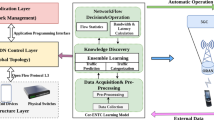Abstract
Network traffic classification is a fundamental and intricate component of network management in the modern, high-tech era of 5G architectural design, planning of resources, and other areas. Investigation of traffic classification is a key responsibility of traffic engineering in SDN. SDN is a network programmability technology used in 5G networks that divides the control plane from the data plane. It also points the way for autonomous and dynamic network control. SDN needs data from the classification system’s flow statistics to apply the appropriate network flow policies. To control the volume of heterogeneous network traffic data in 5G network service, the network administrator must implement a carefully supervised traffic investigation system. This study uses machine learning techniques to examine alternative ways of handling heterogeneous network traffic. The suggested approach is Ensemble Learning for Automated Network Traffic Categorization. i.e., CatBoosting for Automated network traffic classification for multiclass (Cat-ANTC) predicts traffic categorization and offers a higher prediction accuracy than individual models and a more regularized model formalization to decrease over-fitting and boost efficiency. The Cat-ANTC is evaluated using benchmark network traffic datasets that are openly accessible and contrasted with current classifiers and optimization methods. It is clear that when compared to the currently used ensemble techniques, the suggested ensemble methodology produces promising outcomes. Additionally, the proposed method is tested and shown to perform better than the classification of traffic flow using the current model.









Similar content being viewed by others
Data availability
Data available on request due to ethical restrictions.
References
Foukas X, Patounas G, Elmokashfi A, Marina MK (2017) Network slicing in 5g: survey and challenges. IEEE Commun Mag 55(5):94–100
Kobbaey T, Hamzaoui R, Ahmad S, Al-Fayoumi M, Thomos N (2021) Enhanced collision resolution and throughput analysis for the 802.11 distributed coordination function. Int J Commun Systems 34(16):4953
Popovski P, Trillingsgaard KF, Simeone O, Durisi G (2018) 5g wireless network slicing for eMBB, URLLC, and mMTC: A communication-theoretic view. IEEE Access 6:55765–55779
Afolabi I, Taleb T, Samdanis K, Ksentini A, Flinck H (2018) Network slicing and softwarization: a survey on principles, enabling technologies, and solutions. IEEE Commun Surv Tutor 20(3):2429–2453
On 5G architecture: 5G PPP architecture working group, V.: 5G architecture. https://5g-ppp.eu/wp-content/uploads/2014/02/5G-PPP-5G-Architecture-WP-For-public-consultation.pdf/ (2014)
Wang M, Cui Y, Wang X, Xiao S, Jiang J (2017) Machine learning for networking: workflow, advances and opportunities. IEEE Netw. 32(2):92–99
Nunes BAA, Mendonca M, Nguyen X-N, Obraczka K, Turletti T (2014) A survey of software-defined networking: past, present, and future of programmable networks. IEEE Commun Surv Tutor 16(3):1617–1634
Abbas K, Khan TA, Afaq M, Song W-C (2021) Network slice lifecycle management for 5g mobile networks: an intent-based networking approach. IEEE Access 9:80128–80146
Xie J, Yu FR, Huang T, Xie R, Liu J, Wang C, Liu Y (2018) A survey of machine learning techniques applied to software defined networking (sdn): research issues and challenges. IEEE Commun Surv Tutor 21(1):393–430. https://doi.org/10.1109/comst.2018.2866942
Adedeji PA (2020) Hybrid renewable energy-based facility location: a integrated multi-criteria decision-making (MCDM) approach. University of Johannesburg (South Africa)
Cisco: Global traffic (2021) https://www.cisco.com/
Dataset T (2016) Dataset details. https://www.unb.ca/cic/datasets/vpn.html
Li W, Moore AW (2007) A machine learning approach for efficient traffic classification. In: 2007 15th international symposium on modeling, analysis, and simulation of computer and telecommunication systems. IEEE, pp 310–317
Perera Jayasuriya Kuranage M, Piamrat K, Hamma S (2020) Network traffic classification using machine learning for software defined networks. In: Machine learning for networking: second IFIP TC 6 international conference, MLN 2019, Paris, France, December 3–5, 2019, Revised selected papers 2. Springer, pp 28–39
Parsaei MR, Sobouti MJ, Khayami SR, Javidan R (2017) Network traffic classification using machine learning techniques over software defined networks. Int J Adv Comput Sci Appl 8(7):220–225
Perera Jayasuriya Kuranage M, Piamrat K, Hamma S (2019) Network traffic classification using machine learning for software defined networks. In: International conference on machine learning for networking. Springer, pp 28–39
Audah M, Chin TS, Zulfadzli Y, Lee CK, Rizaluddin K (2019) Towards efficient and scalable machine learning-based qos traffic classification in software-defined network. In: International conference on mobile web and intelligent information systems. Springer, pp 217–229 . https://doi.org/10.1007/978-3-030-27192-3_17
Aksoy A, Gunes MH (2019) Automated IoT device identification using network traffic. In: ICC 2019-2019 IEEE international conference on communications (ICC). IEEE, pp 1–7
Żelasko D, Pławiak P (2021) Ensemble learning techniques for transmission quality classification in a pay & require multi-layer network. Int J Appl Math Comput Sci 31(1):135–153
Rasteh A, Delpech F, Aguilar-Melchor C, Zimmer R, Shouraki SB, Masquelier T (2022) Encrypted internet traffic classification using a supervised spiking neural network. Neurocomputing 503:272–282
Zhou K, Wang W, Wu C, Hu T (2020) Practical evaluation of encrypted traffic classification based on a combined method of entropy estimation and neural networks. ETRI J 42(3):311–323
Zaki FAM, Chin TS (2019) Fwfs: selecting robust features towards reliable and stable traffic classifier in SDN. IEEE Access 7:166011–166020
Perera Menuka KP, Hamma S (2019) Network traffc classification using machine learning for software defined networks. IFIP Int Conf Mach Learn Netw 02379020
Yao H, Liu C, Zhang P, Wu S, Jiang C, Yu S (2019) Identification of encrypted traffic through attention mechanism based long short term memory. IEEE Trans Big Data 8(1):241–252
Lin K, Xu X, Gao H (2021) Tscrnn: a novel classification scheme of encrypted traffic based on flow spatiotemporal features for efficient management of IIoT. Comput Netw 190:107974
Afuwape AA, Xu Y, Anajemba JH, Srivastava G (2021) Performance evaluation of secured network traffic classification using a machine learning approach. Comput Stand Interfaces 78:103545
Raikar MM, Meena S, Mulla MM, Shetti NS, Karanandi M (2020) Data traffic classification in software defined networks (SDN) using supervised-learning. Procedia Comput Sci 171:2750–2759
Yu C, Lan J, Xie J, Hu Y (2018) Qos-aware traffic classification architecture using machine learning and deep packet inspection in SDNs. Procedia Comput Sci 131:1209–1216
Alekseeva D, Stepanov N, Veprev A, Sharapova A, Lohan ES, Ometov A (2021) Comparison of machine learning techniques applied to traffic prediction of real wireless network. IEEE Access 9:159495–159514
Hall MA (2000) Correlation-based feature selection of discrete and numeric class machine learning. University of Waikato, Department of Computer Science
Wosiak A, Zakrzewska D (2018) Integrating correlation-based feature selection and clustering for improved cardiovascular disease diagnosis. Complexity 2018:2520706
JohannesFischer: correlation based feature selection (2021) https://johfischer.com/2021/08/06/correlation-based-feature-selection-in-python-from-scratch/
Chen T, Guestrin C (2016) Xgboost: a scalable tree boosting system. In: Proceedings of the 22nd ACM Sigkdd international conference on knowledge discovery and data mining. pp 785–794. https://doi.org/10.48550/arXiv.1603.02754
Veronika Dorogush A, Ershov V, Gulin A (2018) Catboost: gradient boosting with categorical features support. arXiv e-prints 1810.11363
Hancock JT, Khoshgoftaar TM (2020) Catboost for big data: an interdisciplinary review. J Big Data 7(1):1–45
Prokhorenkova L, Gusev G, Vorobev A, Dorogush AV, Gulin A (2018) Catboost: unbiased boosting with categorical features. Adv Neural Inf Process Syst 31
Zhou F, Pan H, Gao Z, Huang X, Qian G, Zhu Y, Xiao F (2021) Fire prediction based on catboost algorithm. Math Probl Eng 2021:1–9
Abu Salem FK, Jurdi M, Alkadri M, Hachem F, Dhaini HR (2022) Feature selection approaches for predictive modelling of cadmium sources and pollution levels in water springs. Environ Sci Pollut Res 29:1–16
Géron A (2017) Hands-on machine learning with Scikit-learn and Tensorflow: concepts. Tools, and Techniques to build intelligent systems
OpenFlownetwork: RyuApplications (2014). https://ryu-sdn.org
Kaur K, Singh J, Ghumman NS (2014) Mininet as software defined networking testing platform. In: International conference on communication, computing & systems (ICCCS). pp 139–42
0x04, V....W.P.: OpenFlow switch specification (2012) https://www.opennetworking.org/wp-content/uploads/2014/10/openflow-spec-v1.3.0.pdf
Antonio Pescapè AB (2021) Network monitoring and measurements,COMICS. https://traffic.comics.unina.it/software/ITG/documentation.php
Draper-Gil G, Lashkari AH, Mamun MSI, Ghorbani AA (2016) Characterization of encrypted and vpn traffic using time-related. In: Proceedings of the 2nd international conference on information systems security and privacy (ICISSP). pp 407–414
Lu B, Luktarhan N, Ding C, Zhang W (2021) ICLSTM: encrypted traffic service identification based on inception-LSTM neural network. Symmetry 13(6):1080
Zhou Y, Shi H, Zhao Y, Ding W, Han J, Sun H, Zhang X, Tang C, Zhang W (2023) Identification of encrypted and malicious network traffic based on one-dimensional convolutional neural network. J Cloud Comput 12(1):1–10
Funding
This research received no external funding.
Author information
Authors and Affiliations
Contributions
Each author who made a contribution to the study’s conceptualization and design contributed to the research activity.
Corresponding author
Ethics declarations
Conflict of interest
The authors declare no conflict of interest.
Ethical approval
The proposed work does not include any ethically approved human or animal experiments.
Additional information
Publisher's Note
Springer Nature remains neutral with regard to jurisdictional claims in published maps and institutional affiliations.
Rights and permissions
Springer Nature or its licensor (e.g. a society or other partner) holds exclusive rights to this article under a publishing agreement with the author(s) or other rightsholder(s); author self-archiving of the accepted manuscript version of this article is solely governed by the terms of such publishing agreement and applicable law.
About this article
Cite this article
Paramasivam, S., Leela Velusamy, R. & Nishaanth, J.V. Categorical learning for automated network traffic categorization for future generation networks in SDN. Computing (2024). https://doi.org/10.1007/s00607-024-01277-y
Received:
Accepted:
Published:
DOI: https://doi.org/10.1007/s00607-024-01277-y
Keywords
- Multi-class traffic categorization
- Fifth generation
- Ensemble learning
- Software defined network
- OpenFlow policies
- Categorical learning




